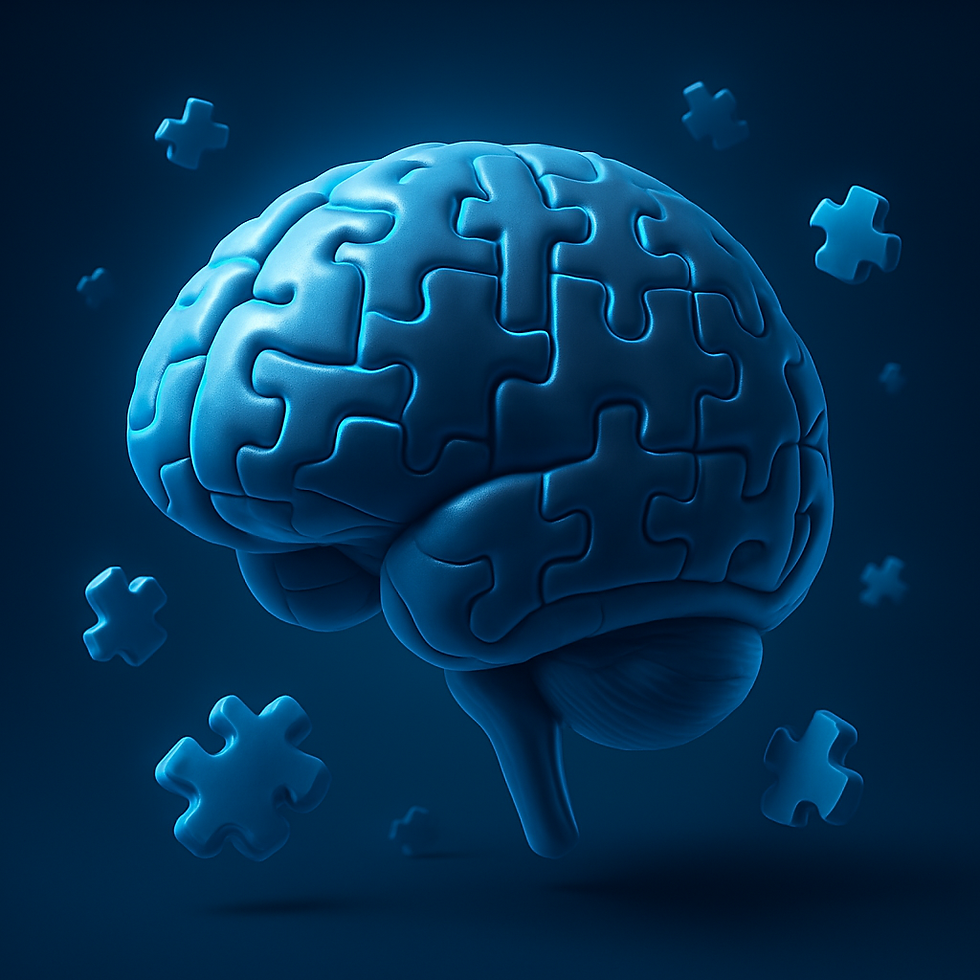Piecing Together the Puzzling History of Autism Diagnosis
- Kenneth Anshewitz
- May 22
- 4 min read
When I was born, autism was still called “Asperger’s” in many circles. It wasn’t mainstream. It wasn’t visible. And it certainly wasn’t well understood. For many people, diagnosis came late—if at all. For most with a late diagnosis, the signs were clear, yet they were brushed off as quirks, shyness, or just being “difficult.” Only later did the puzzle pieces start to fit.
The history of autism diagnosis is as fragmented as the very condition it seeks to define. What started as misdiagnosis has become a case study in how medicine evolves—slowly, imperfectly, and always under pressure from culture, advocacy, and technology.

The Misdiagnosis Era (Pre-1940s): Childhood Schizophrenia
In the early 20th century, children displaying autistic behaviors—withdrawal, mutism, rigid routines—were often labeled schizophrenic. These weren’t just clinical mistakes. They were catastrophic. Treatments included institutionalization, psychoanalysis, and electroconvulsive therapy. The underlying assumption was simple but flawed: the child was broken.
There was no concept of neurodivergence, just dysfunction. These children weren’t seen as different; they were seen as defective.
The Foundational Phase (1943–1980): Kanner vs. Asperger
Then came Leo Kanner in 1943, who described “early infantile autism”—children with profound difficulties in social interaction and a preference for sameness. A year later, Hans Asperger documented children with strong verbal skills and narrow, obsessive interests. These kids weren’t psychotic; they were different. But Asperger’s work remained obscure in English-speaking medicine for decades.
The DSM-II (1968) still grouped autism under schizophrenia. Treatments began shifting toward behaviorist models—particularly Applied Behavior Analysis (ABA), which sought to normalize autistic behaviors through conditioning. While it moved away from institutionalization, it focused heavily on compliance, sometimes at the expense of the child’s identity.
The Diagnostic Explosion (1980s–1990s): From Niche to Recognition
The DSM-III (1980) formally recognized autism as its own category: Infantile Autism. By DSM-IV (1994), the definition expanded under the umbrella of Pervasive Developmental Disorders (PDD), encompassing Autism, Asperger’s, Rett Syndrome, and PDD-NOS.
Media like Rain Man sparked public awareness. Advocacy from parents and researchers pushed the conversation into mainstream culture. Schools began offering services under IDEA, and pediatricians ramped up early screening.
Still, most diagnoses targeted more “profound” presentations—non-verbal, institution-bound children. Those with higher-functioning traits were often left out or misclassified.
The Spectrum Era (2000s–2010s): ASD Consolidation and Neurodiversity
With the DSM-5 in 2013, the fragmented diagnoses were folded into a single continuum: Autism Spectrum Disorder (ASD). Asperger’s and PDD-NOS were no longer separate. The spectrum model acknowledged diversity in presentation, function, and support needs.
The neurodiversity movement shifted the paradigm. Autism was no longer a disease to cure—it was a difference to understand. Interventions broadened: social skills groups, AAC devices, CBT for anxiety, sensory integration, IEPs in schools. The goal became support and inclusion, not correction.
The Precision Medicine Era (2020s–Present): Biology, Behavior, and Beyond
Today, autism diagnosis is entering a new frontier. We’re moving from subjective checklists to objective metrics—eye-tracking, EEG, DNA panels, and AI-powered screening tools. The CDC now recognizes profound autism as a distinct clinical need, requiring full-time care and intensive support.
We’re also refining how we label and understand the condition. The outdated “low-functioning” vs. “high-functioning” binary is giving way to support levels (1 through 3), which better reflect real-world needs and capabilities.
Treatment is increasingly personalized—blending behavioral therapy, medication, parent training, nutritional support, and even psychedelic-assisted therapies under trial.
Prevalence Trends: Why Numbers Are Rising
Here’s the kicker: the number of people with profound autism has stayed relatively flat. What’s changed is our ability to identify and include those with non-profound autism—those who speak, attend regular schools, or mask their symptoms well into adulthood.
1940s–1960s: Seen in fewer than 1 in 10,000 kids.
1980s: <1 in 2,500
2000s: 1 in 150 (CDC formal tracking begins)
2018: 1 in 59
2023: 1 in 36
This isn’t merely an epidemic of awareness—it’s a signal of deeper, underlying factors. While improved diagnostics and broader definitions have undeniably contributed to the rise in autism prevalence, they don't tell the whole story. A 2009 study by the UC Davis MIND Institute found that the seven- to eight-fold increase in autism cases in California since 1990 cannot be fully explained by changes in diagnostic criteria or increased awareness. This suggests that other elements, potentially environmental or biological, are influencing the uptick in diagnoses. Therefore, while we're now better at identifying and supporting individuals across the autism spectrum, it's imperative to delve deeper into the root causes driving this increase.
Practical Takeaways: What Parents and Clinicians Should Know
Early Signs Can Be Subtle: Especially in girls and verbal children. Don’t wait for extreme behaviors to take action.
Precision Is the Future: Push for diagnostics that go beyond checklists—genetic panels, digital phenotyping, neuroimaging.
Profound Needs Still Exist: One in 130 children have profound autism. Tailored interventions and full-time support models must stay funded and prioritized.
Inclusion Isn’t Optional: Schools and workplaces must evolve—not just legally, but culturally—to accommodate and celebrate neurodiversity.
Closing Thoughts: A Personal Note
For those of us who went undiagnosed in childhood, the pain of being misunderstood lingers. But so does the hope. We now have language, tools, and community. The field still has a long way to go, especially in equity and adult diagnosis, but the trajectory is forward.
Autism isn’t a monolith—it’s a mosaic. And understanding it fully means embracing that complexity, not simplifying it.
Sources: CDC (2023), DSM-III, DSM-IV, DSM-5, Tony Attwood, Leo Kanner (1943), Hans Asperger (1944), IDEA.gov, Autism Speaks, NIMH




Comments